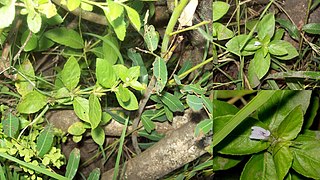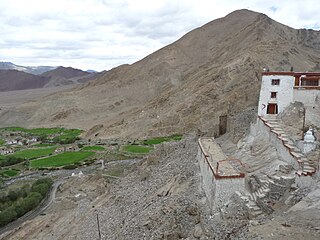
Hygrophila costata, with the common names glush weed, gulf swampweed, and yerba de hicotea, is an aquatic plant

Angophora costata, commonly known as Sydney red gum, rusty gum or smooth-barked apple, is a species of tree that is endemic to eastern Australia. Reaching 30 m (100 ft) in height, the species has distinctive smooth bark that is pinkish or orange-brown when new and fades to grey with age. Its lance-shaped leaves are arranged in opposite pairs along the stems, with white or creamy white flowers appearing from October to December. The flower buds are usually arranged in groups of three, followed by ribbed, oval or bell-shaped fruit.

Anisoptera costata is an endangered species of plant in the family Dipterocarpaceae. The name costata is derived from Latin and describes the prominent venation of the leaf blade. A huge emergent tree up to 65 m high, it is found in evergreen and semi-evergreen lowland tropical seasonal forests of Indo-Burma and in mixed dipterocarp forests of Malesia.

Nyoma is a principal village of southern Ladakh in India, the headquarters of an eponymous subdivision, tehsil and block in the Leh district. It is located on the bank of Indus River, after its 90-degree bend near Dungti and before the valley narrows to a gorge near Mahe. A Buddhist monastery ("gompa") is located on the hill at the back of the village.

Kharnak is a village in the Leh district of Ladakh, India. It is located in the Nyoma tehsil.

Chumathang is a village in Leh District, Ladakh in northern India on the banks of the Indus river.
Nyoma is a genus of longhorn beetles of the subfamily Lamiinae, containing the following species:

Tarchit is a village in the Leh district of the Indian union territory of Ladakh. It is located in the Nyoma tehsil.

Kumgyam is a village in the Leh district in the Indian union territory of Ladakh. It is located in the Nyoma tehsil.

Anlay is a village in the Leh district in the Indian union territory of Ladakh. It is located in the Nyoma tehsil.

Tukla is a village in the Leh district of Ladakh, India. It is located in the Nyoma tehsil.

Himya is a village in the Leh district in the Indian union territory of Ladakh. It is located in the Nyoma tehsil.

Teri is a village in the Leh district of Ladakh, India. It is located in the Nyoma tehsil.

Mood is a village in the Leh district of Ladakh, India. It is located in the Nyoma tehsil.

Kerey is a village in Leh district in the Indian union territory of Ladakh. It is located in the Nyoma tehsil.

Samad Rakchan is a village in the Leh district of the Indian union territory of Ladakh. It is located in the Nyoma tehsil.
Nyoma fuscomaculata is a species of beetle in the family Cerambycidae. It was described by Breuning in 1971. It is known from Mozambique and Zimbabwe.
Nyoma fuscosignata is a species of beetle in the family Cerambycidae. It was described by Breuning in 1948, originally under the genus Sophroniella. It is known from Ghana, the Ivory Coast, and the Democratic Republic of the Congo.

Hakea costata, commonly known as the ribbed hakea, is a shrub in the family Proteaceae native to Western Australia. A multi-stemmed small shrub producing attractive pink or white brush-like blooms rich in nectar from July to October.
Grevillea costata is a shrub of the genus Grevillea native to an area along the west coast of the Mid West region of Western Australia.






